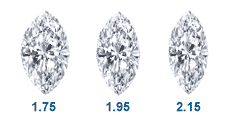Contact
Click below to speak to a Diamond Consultant or customer service.
or
Live Chat8:00 am - 6:00 pm CST (Mon - Fri)

Click below to speak to a Diamond Consultant or customer service.
or
Live Chat8:00 am - 6:00 pm CST (Mon - Fri)

The football-shaped marquise diamonds are a modified brilliant-cut. The name is derived from the Marquise of Pompadour, for whom King Louis XIV of France allegedly had a stone fashioned to resemble what he considered her perfectly shaped mouth. Because marquise diamonds are long and narrow, they can also create the illusion of greater size. Carat for carat, the marquise diamond has one of the largest crown surface areas of any diamond shape, making it a good choice when trying to maximize the perceived size of a diamond. Like the oval diamond, the marquise cut diamond's elongated shape can make the finger of the wearer appear longer and slimmer.
Marquise diamonds posses some degree of bow-tie, varying from near invisible to severe. The visibility of a bow-tie effect cannot be ascertained by reviewing the diamond certificate or dimensions, but only upon visual inspection. If you are interested in purchasing a marquise cut diamond, but would like to have it inspected first, please contact a diamond consultant, who can review diamonds on your behalf. chat online, or email [email protected].

Personal preference should dictate how narrow or fat of a marquise diamond you choose, although a length to width ratio of 1.75 -2.15 is considered the classic marquise cut. Every Lumera Diamond includes precise measurements, as well as the length to width ratio, so you know the exact shape of the marquise cut diamond you are considering.
Symmetry is very important in marquise cuts. The two end points should align with each other, and the right and left sides should form a near mirror image. Even a slight misalignment in the points can result in an off kilter look in the final setting. For this reason, excellent or very good symmetry is strongly recommended.
A marquise diamond should always be set with prongs to protect the two points (the most likely location for chipping). Because these points were once nearest the outer edge of the rough stone, flaws such as naturals, extra facets, and other inclusions may be located here. Since the points are covered by prongs, these flaws will be invisible once the diamond is set. The only remaining concern would be if the flaws are significant enough to affect the stability of the diamond (this is extremely rare, however).
The chart below serves as a general guideline for evaluating the cut of a marquise diamond.
| EXCELLENT | VERY GOOD | GOOD | FAIR | POOR | |
|---|---|---|---|---|---|
| Table % | 53 - 63 |
52
or 64 - 65 |
51
or 66 - 68 |
50
or 69 - 70 |
< 50
or > 70 |
| Depth % | 58 - 62 |
56 - 57.9
or 62.1 - 66 |
53 - 55.9
or 66.1 - 71 |
50 - 52.9
or 71.1 - 74 |
< 50
or > 74 |
| Girdle | Very Thin - Slightly Thick |
Very Thin
to Thick |
Very Thin
to Very Thick |
Ex. Thin
to Ex. Thick |
|
| Culet | None | Very Small | Small | Medium | > Medium |
| L/W Ratio | 1.85 - 2.00 |
1.75 - 1.84
or 2.01 - 2.15 |
1.65 - 1.74
or 2.16 - 2.30 |
1.55 - 1.64
or 2.31 - 2.45 |
> 1.55
or < 2.45 |
Evaluating color in a marquise cut diamond is subjective. Keep in mind that many buyers may actually prefer the ever so slightly warmer colors of a G-H diamond over the cool colorlessness of a D-F diamond. In fact, most of the premium in price associated with a marquise cut diamond at the higher end of the color scale is driven by supply and demand; customers want the D-F color grades, and are willing to pay a premium to get them. In a world without diamond color grading, the price premium for higher grades would be much lower, as the actual differences in color are difficult to perceive.
In larger marquise diamonds (over 1 carat), the color may appear slightly darker at the points. For this reason, buyers may choose to move up one color grade as compared to other diamond shapes. The color chart below provides a general guide for evaluating color in marquise diamonds.
| EXCELLENT | VERY GOOD | GOOD | FAIR | POOR | |
|---|---|---|---|---|---|
| < .50 ct. | D - G | H - I | J - K | L - M | > M |
| .51-1.0 ct. | D - F | G | H - I | J - K | > K |
| 1.0-2.0 ct. | D - F | G - H | I - J | > J | |
| > 2.0 ct. | D - F | G | H - I | > I | |
| Fluoro | None | Faint - Med | Strong | Very Strong | |
Like color, evaluating clarity in marquise diamonds is subjective. GIA provides excellent help with their clarity grades. Still, it is important to understand that each customer will have a unique standard for clarity. Some may be perfectly comfortable with an inclusion as long as they cannot easily see it. Others may insist on a more technically flawless appearance. The clarity chart below provides a general guide for evaluating clarity in marquise diamonds.
| EXCELLENT | VERY GOOD | GOOD | FAIR | POOR | |
|---|---|---|---|---|---|
| < .50 ct. | FL - VS2 | SI1 - SI2 | I1 | I2 | > I2 |
| .51-1.0 ct. | FL - VS1 | VS2 - SI1 | SI2 | I1 - I2 | > I2 |
| 1.0-2.0 ct. | FL - VVS2 | VS1 - VS2 | SI1 - SI2 | I1 | > I1 |
| > 2.0 ct. | FL - VVS2 | VS1 - VS2 | SI1 | SI2 | > SI2 |
In terms of price-per-carat, the marquise diamond is less expensive than round. When a marquise shape is cut from the natural rough diamond, more of the material is saved, as compared to round. This higher efficiency translates to a lower price per carat.
Because marquise cuts have a relatively shallow profile, they also tend to look larger than other shapes on a carat per carat basis, making them an attractive option for some. Overall, marquise diamonds are not significantly more or less expensive than other fancy diamond shapes - although temporary price variances by shape can be driven by factors of supply and demand.
Marquise cut engagement rings make up less than 5% of total engagement ring sales. However, when you consider that round, princess and cushion cut together account for about 85% of engagement diamond shapes, the marquise’s share is in line with the other six common shapes (each about 2-4% of sales). Meaning, while marquise cut diamonds are a small minority of total diamond sales, they are roughly commensurate with many other shapes (such as oval, pear, and asscher).
If you were to cut a diamond with only one goal in mind - optimal light performance, you would cut a round diamond. By nature of their shape, most fancy shapes are detrimental to light performance; more so for elongated shapes (such as marquise, pear, and oval cuts). The so-called “bow-tie” is a common description for a darkened area that often appears in the diamond’s center when viewed from above.
The type of lighting can dramatically impact the visibility of any bow-tie effect. The cut and size of the diamond also matter. The best way to avoid a pronounced bow-tie effect is to work with a Lumera Diamond Consultant prior to making a purchase. A consultant will be glad to point out any flaws or drawbacks in a given diamond, so that an informed purchase can be made.
A marquise cut diamond ring is most vulnerable to damage at the extreme tips; these areas must be covered by a prong setting to keep the diamond safe, as well as secure. For this reason, tension settings are not recommended.
What is a good proportion for a marquise diamond? When choosing a marquise cut diamond, several proportions should be considered, including table, depth, girdle, culet size, symmetry, and length-to-width ratio ratio. Use the Marquise diamond cut chart on this page to see what ranges are suitable for each of these proportional measurements.
Dividing a marquise diamond’s length (for instance 6 mm) by the diamond’s width (say, 3 mm) will yield a ratio (2.00 in this case) - called the length-to-width ratio ratio. Typically, buyers prefer a length-to-width ratio of 1.75 - 2.15 in a marquise cut diamond.
In simple terms, symmetry refers to the marquise diamond’s balance of shape. If a marquise diamond were divided in half, perfect symmetry would mean that each half would be identical mirror images. When symmetry is poor in a marquise diamond engagement ring, the extreme points of the diamond will appear misaligned, causing the marquise engagement ring to look as if it has been damaged.
As with all diamond shapes, clarity tends to become very important the moment any inclusions are visible to the naked eye. Marquise cut diamonds, like all brilliant cuts, tend to hide smaller inclusions very well compared to step cut diamonds (such as the emerald cut). We recommend that no purchase be made without first having a Lumera Diamond Consultant review the diamond for visible inclusions, as well as to address any other concerns.
When choosing a diamond, the relationship between color and clarity is not static. Whichever flaw is most prominent to the naked eye (whether color or clarity) tends to be the more important factor in a given diamond. Rather than ranking the importance of color or clarity, a better approach is to address each individually. Find a diamond that meets your minimum requirements for color, but not needlessly higher. Then do the same for clarity. A Lumera Diamond Consultant can be invaluable in this process. Often, this approach leads to spending less overall, or at least not overspending in an effort to avoid the negative impact of poor clarity or color.
A marquise cut diamond ring is the best choice for any wearer who prefers the marquise shape itself. The choice of a center diamond shape should not be driven by any factors beyond the wearer’s personal preference. For the wearer who enjoys the marquise shape, a marquise engagement ring is an excellent choice.
The marquise cut diamond shape has been around for a little over 300 years. The shape was first created by a french jeweler as a gift from Louis XIV to the Marquise of Pompadour - hence the name of the cut. Marquise cuts have risen and fallen in popularity, but only in rare instances have accounted for more than 10% of engagement ring diamond shapes.
Questions about shape or other aspects of a diamond? Ask a diamond consultant for answers. A consultant will answer any questions you have, and if you like, search for diamonds on your behalf that match your criteria. chat online, or email [email protected].

